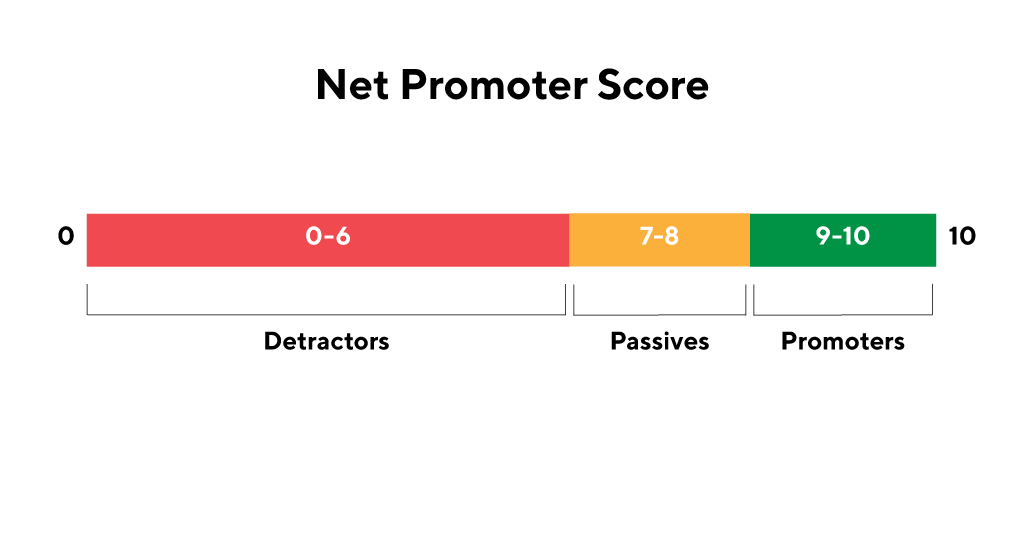What is a Net Promoter Score?
A net promoter score is a method of using a single survey question to gauge customer satisfaction with a product. Businesses can send out this question— “On a scale of 0 to 10, how likely are you to recommend [our product or company]?”—at various stages of the customer’s journey.
Where Did the Net Promoter Score Originate?
Fred Reichheld, a partner at Bain & Company, developed the net promoter score (also called the NPS or NPS score) in 2003. His goal was to give businesses a quick pulse check to learn how well they generated customer satisfaction and loyalty.
Bain & Company’s website offers free literature on the Net Promoter System.
Why Use a Calculated Net Promoter Score?
Businesses can use NPS surveys to gain feedback on any aspect of their customers’ experience. A product team might send out the NPS question immediately after a customer uses the company’s software product for the first time. They might also send it out after the customer has been using the product for 90 days or a year.
Organizations in all types of industries can use NPS scoring to gauge customer satisfaction. Customers might receive the NPS question after shopping at a grocery store, renting a car, or purchasing a product in a shopping mall.

How to Calculate an NPS Score
When you send users the NPS System’s one question (“How likely are you to recommend us?”), they can respond with a score of 0 to 10. Based on their scores, you’ll place users in one of the three following categories:
- Promoters (scores of 9 or 10)
These are your enthusiastic and loyal customers.
- Passives (scores of 7 or 8)
These users are satisfied with your product but not enthusiastic enough to promote it.
- Detractors (scores of 0 to 6)
These are unhappy customers unlikely to buy from you again. They may even discourage others from your product.
To calculate your Net Promoter Score score, you subtract the percentage of detractors from the percentage of promoters. (You will set all passive responses aside; they do not factor in.)
If 10% of respondents are detractors, 10% are passives, and 80% are promoters, you will calculate your NPS score by subtracting 10 (your percentage of detractors) from 80 (your promoters). Your result will be a net promoter score of 70. (A great score.)
Note: For net promoter score calculation, you will treat responses in each category identically, regardless of the specific numbers. For example, responses of 1 and 6 each count equally as detractors.
What’s Considered a Good Net Promoter Score?
Net Promoter Score scores can range from -100 (all detractors and no promoters) to 100 (all promoters and no detractors). The closer to 100, the better.
Businesses will bring their subjective views to their net promoter scores, and these scores can be open to interpretation. But here is a good rule of thumb:
- 70 or more: outstanding
- 50 to 69: strong
- 49 or less: needs improvement
- Below 0: red flag!
What Do You Do With Your Net Promoter Score?
A high NPS score should be an organization-wide objective, not just a metric the product or customer success team tracks.
If your NPS is lower than you’d like, raising that score should become a strategic priority for your business. To make it a strategic priority, you will want to open communication channels across your organization and set specific, measurable goals for your cross-functional teams. The aligned goals will ensure everyone knows what is happening with your NPS, recognizes the value of improving it, and understands how they can contribute to that effort.
Takeaways: Should You Use the NPS Method?
An NPS survey gives a business a quick and simple way to gauge how it is performing with customers at any time. For this reason, a net promoter score can be a valuable key performance indicator (KPI).
Although it is a broad metric that doesn’t reveal customers’ specific likes or dislikes, the net promoter score can be a helpful guide to help businesses reduce churn. That is because a low NPS score indicates you are at elevated risk of losing customers. Knowing this can be an essential first step to help your team identify specific problems so that you can address them.
As the chart below illustrates, your ability to increase your NPS can directly impact your company’s bottom line.
As you can see, the NPS score is so important. Checking in with your customer base periodically to learn how loyal they’re feeling toward your product is a great way to give your team the business intelligence they need to improve long-term customer relationships and increase your company’s revenue.

